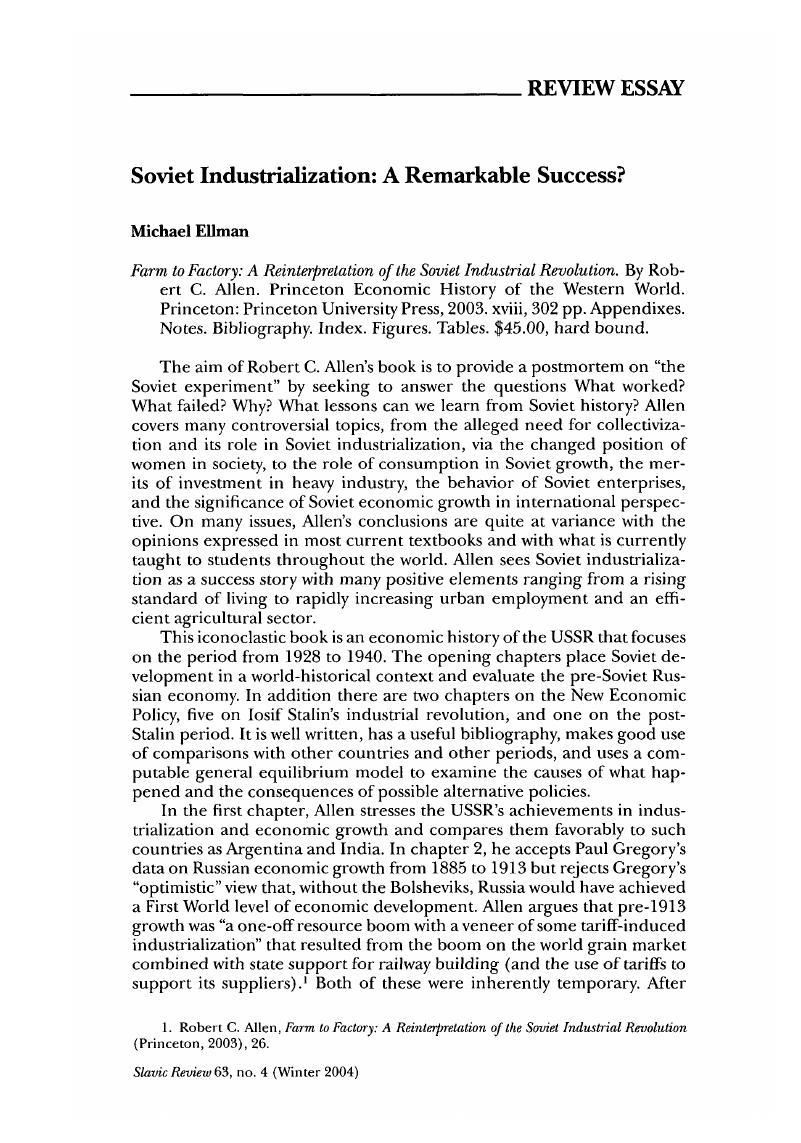Article contents
Soviet Industrialization: A Remarkable Success?
Published online by Cambridge University Press: 27 January 2017
Abstract

- Type
- Review Essay
- Information
- Copyright
- Copyright © Association for Slavic, East European, and Eurasian Studies. 2004
References
1. Allen, Robert C., Farm to Factory: A Reinterpretation of the Soviet Industrial Revolution (Princeton, 2003), 26 Google Scholar.
2. Piatnadtsatyi s“ezd VKP(b): Stenograficheskii otchet (Moscow, 1962), 2:1442. According to Lazar’ Kaganovich, this formulation was based on a proposal made by Iosif Stalin himself. See Kaganovich, Lazar’, Pamiatnye zapiski (Moscow, 1996), 400 Google Scholar.
3. Ellman, Michael, Socialist Planning, 2d ed. (Cambridge, Eng., 1989), 107 Google Scholar; Harrison, Mark, “National Income,” in Davies, R. W., Harrison, Mark, and Wheatcroft, S. G., eds., The Economic Transformation of the Soviet Union, 1913-1945 (Cambridge, Eng., 1994), 52–53 Google Scholar.
4. Wheatcroft, Stephen G., “The Great Leap Upwards: Anthropometric Data and Indicators of Crises and Secular Change in Soviet Welfare Levels,” Slavic Revieiu 58, no. 1 (Spring 1999): 51 Google Scholar.
5. Sen, Amartya K., Poverty and.Fam.ines (Oxford, 1981)Google Scholar.
6. Chapman, Janet G., Real Wages in Soviet Russia since 1928 (Cambridge, Mass., 1963)CrossRefGoogle Scholar; Bergson, Abram, The Real National Income of Soviet Russia since 1928 (Cambridge, Mass., 1961)Google Scholar.
7. Surprisingly, when criticizing Bergson, Allen does not refer to Igor Birman's criticism of CIA estimates of Soviet consumption in a later period. See Birman, Igor, Personal Consumption in the USSR and the USA (Basingstoke, Eng., 1989)CrossRefGoogle Scholar.
8. Khanin, G. I., Ekonomicheskaia istoriia Rossii v noveishee vremia (Novosibirsk, 2003), 1:29 Google Scholar.
9. Osokina, Elena A., Zafasadom “Stalinskogo izobiliia“: Raspredelenie i rynok v snabzhenii naseleniia vgody industrializatsii, 1927-1941 (Moscow, 1998), 206–18Google Scholar. An English translation of this book is also available: Osokina, Elena A., Our Daily Bread: Socialist Distribution and the Art of Survival in Stalin's Russia, 1927-1941 (Armonk, N.Y., 2001)Google Scholar.
10. Hunter, Holland and Szyrmer, Janusz, Faulty Foundations: Soviet Economic Policies, 1928-1940 (Princeton, 1992), 41 Google Scholar and 47.
11. Davies, R. W., Harrison, Mark, and Wheatcroft, S. G., eds., The Economic Transformation of the Soviet Union, 1913-1945 (Cambridge, Eng., 1994), 288 Google Scholar, note f. Emphasis in the original.
12. Danilov, V., Manning, R., and Viola, L., eds., Tragediia sovetskoi derevni (Moscow, 1999-2005), vol. 5, bk. 1, docs. 71 Google Scholar, 76, 81, 93, 94, 98, 106, 125, and 127.
13. Osokina, E. A., “Economic Disobedience under Stalin,” in Viola, Lynne, ed., Contending with Stalinism (Ithaca, 2002), 180 Google Scholar.
14. For this figure, see Ellman, Michael, “Soviet Repression Statistics: Some Comments,“ Europe-Asia Studies 54, no. 7 (2002): 1151–72CrossRefGoogle Scholar.
15. Getty, J. A., Rittersporn, G. T., and Zemskov, V., “Victims of the Soviet Penal System in the Pre-War Years: A First Approach on the Basis of Archival Evidence,” American Historical Review 98, no. 4 (October 1993): 1017–49CrossRefGoogle Scholar; Poliakov, I. A. and Zhiromskaia, V. B., eds., Naselenie Rossii v XXveke: Istoricheskie ocherki (Moscow, 2000- ), vol. 1 Google Scholar, chap. 14.
16. Berkhoff, K., Harvest of Despair: Life and Death in Ukraine under Nazi Rule (Cambridge Mass., 2004)Google Scholar, chap. 5.
17. Banac, I., ed., TheDiary ofGeorgiDimitrov (New Haven, 2003), 270 Google Scholar. The colonel was Ilia Starinov and the general secretary of the Comintern Georgi Dimitrov.
18. Allen, Farm toFactory, 151.
19. Gomulka, Stanislaw, Inventive Activity, Diffusion, and the Stages of Economic Croxuth (Aarhus, 1971)Google Scholar; Gomulka, Stanislaw, “Import Led Growth: Theory and Estimation,” in Altmann, F. L., Kyn, O., and Wagener, H.J., eds., On the Measurement of Factor Productivities: Theoretical Problems and Empirical Results (Gottingen, 1976)Google Scholar; Gomulka, Stanislaw, Growth, Innovation and Reform in Eastern Europe (Brighton, Eng., 1986)Google Scholar.
20. Allen, Farm to Factory, 170.
21. Barsov, A. A., Balans stoimostnykh obmenov mezhdu gorodom i derevnei (Moscow, 1969)Google Scholar; Millar, James R., “Mass Collectivization and the Contribution of Soviet Agriculture to the First Five-Year Plan,” Slavic Review 33, no. 4 (December 1974): 750–66CrossRefGoogle Scholar; Ellman, Michael, “Did the Agricultural Surplus Provide the Resources for the Increase in Investment in the USSR during the First Five-Year Plan?” Economic Journal 85 (1975): 844–63CrossRefGoogle Scholar.
22. Kontorovich, Vladimir, “Inflation in the Soviet Investment and Capital Stock Data,” Soviet Studies 41, no. 2 (1989): 318–29CrossRefGoogle Scholar; Kontorovich, Vladimir, “Economists, Soviet Growth Slowdown and the Collapse,“ Europe-Asia Studies 53, no. 5 (2001): 675–95CrossRefGoogle Scholar; Khanin, Ekonomicheskaia istoriia Rossii, 159.
23. Allen, Farm to Factory, 153.
24. For data on world economic growth, see Maddison, A., The World Economy: A Millenial Perspective (Paris, 2001)CrossRefGoogle Scholar. This data clearly shows the importance for the conclusions reached of both the period selected and the countries chosen for comparison.
25. Samuelson, Lennart, Plans for Stalin's War Machine: Tukhachevskii and Military-Economic Planning, 1925—1941 (Basingstoke, Eng., 2000)CrossRefGoogle Scholar.
26. Osokina, Zafasadom “Slalinskogo izobiliia.“
27. For an analysis of the Soviet economy in World War II, see Harrison, M., Accounting/ or War: Soviet Production, Employment, and the Defence Burden, 1940-1945 (Cambridge, Eng., 1996)CrossRefGoogle ScholarPubMed; Harrison, M., “The Soviet Union: The Defeated Victor,” in Harrison, M., ed., The Economics of World War II: Six Great Powers in International Comparison (Cambridge Eng., 1998)CrossRefGoogle Scholar; and Khanin, Ekonomicheskaia istoriia Rossii, 41-61.
- 9
- Cited by


